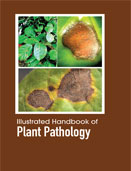Handbooks

Because of the reliance of humans on plants for food, fibers and other resources, understanding plant diseases and their control is of vital importance to our survival. Plant disease epidemics can cause famines, eliminate a thriving industry or poison animals and humans. Plant diseases are the result of infection by other organisms that adversely affect the growth, physiological functioning and productivity of a plant, manifesting outwardly as visible symptoms. All species of plants, wild and cultivated alike, are subject to disease. Although each species is susceptible to characteristic diseases, these are, in each case, relatively few in number. The occurrence and prevalence of plant diseases vary from season to season, depending on the presence of the pathogen, environmental conditions, and the crops and varieties grown. Some plant varieties are particularly subject to outbreaks of diseases; others are more resistant to them. Parasitic organisms that cause disease are called pathogens. This illustrated work in plant pathology outlines how to recognize, treat, and prevent plant diseases.
Plant Pathology is the study of the diseases and disorders of plants. Disease can be defined as a harmful deviation from normal functioning of the physiological processes caused by an infectious agent. Plants, like animals and humans, can also become diseased. In fact, there is a much wider number of plant diseases than there are human or animal diseases simply because there are more plant species involved in agriculture, horticulture and forestry than in medical or veterinary medicine. In the case of plant diseases, the causal agent maybe a fungus, virus, bacterium or a parasitic flowering plant.
Illustrated Handbook of Plant Pathology covers the entire field of plant pathology. Diagnosis, disease management, and the molecular basis of host-pathogen interactions are examined. Control of plant diseases is crucial to the reliable production of food, and it provides significant reductions in agricultural use of land, water, fuel and other inputs. Plants in both natural and cultivated populations carry inherent disease resistance, but there are numerous examples of devastating plant disease impacts, as well as recurrent severe plant diseases (see rice blast, soybean cyst nematode, citrus canker). Plant pathology has been astoundingly successful in providing farmers with methods for managing plant diseases. This success is one of the reasons why famine in today?s world is a relatively rare and isolated event. Nevertheless, plant disease continues to exert a toll on crop and food production. Diseases cause several billions of dollars in lost production worldwide each year, reducing yields by over 500 million tons annually. Continuing advances in the science of plant pathology are needed to improve disease control, and to keep up with changes in disease pressure caused by the ongoing evolution and movement of plant pathogens and by changes in agricultural practices. Plant diseases cause major economic losses for farmers reducing profits and drive up prices of food purchased by consumers. The Illustrated Handbook of Plant Pathology is well illustrated, includes both subject and taxonomic indexes, and provides references for the further reading. The Handbook has been designed primarily for the use of students and researchers engaged in different courses in plant pathology.